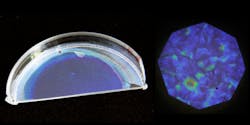Wood-derived cellulose nanocrystals form iridescent film for textile and security applications
| An iridescent biomimetic cellulose multilayer film remains after water that contains cellulose nanocrystals evaporates. Credit: Silvia Vignolini |
Researchers at the University of Cambridge (Cambridge, England) have extracted cellulose nanocrystals from wood pulp, then prompted the nanocrystals to spontaneously self-assemble into chiral (spiral-shaped) nanostructured layers that form optical multilayer thin-film reflectors.1 The reflected spectral band of the film, and thus its color, can be tailored by varying the humidity conditions during self-assembly.
The result is a material that could replace toxic pigments used in the textile and security industries.
Biomimetic film
The material mimics some biological substances: for example, in plants such as Pollia condensata, striking iridescent and metallic colors are produced by cellulose fibers arranged in chiral stacks.
To make the films, the researchers suspended the extracted cellulose nanocrystals in water; the rod-shaped nanocrystals spontaneously assembles into nanostructured chiral layers as the water evaporates. The researchers used a spectroscopic setup to measure the bandwidth of the spectral reflection and thus the amount of disorder in the fabricated samples.
"Cellulose is a well-known, cheap material used in the paper and pharmaceutical industries, and is also used in filters and insulating materials; however, its potential is not yet fully exploited," said Ahu Gumrah Dumanli of Cambridge University's Cavendish Laboratory. "It is important to understand the materials fully if we want to use them for application in optical devices."
Source: http://www.cam.ac.uk/research/news/taking-inspiration-from-natures-brightest-colours
REFERENCE:
Dumanli, A. G. et al., Advanced Optical Materials (2014); doi: 10.1002/adom.201400112
